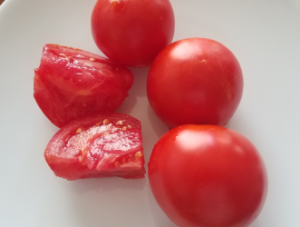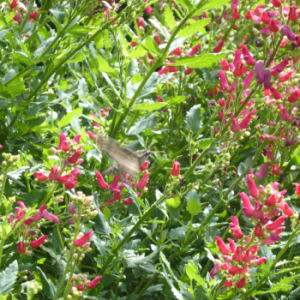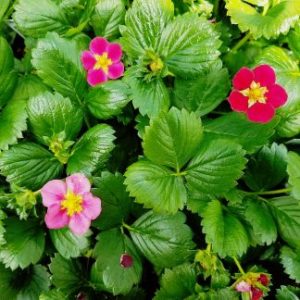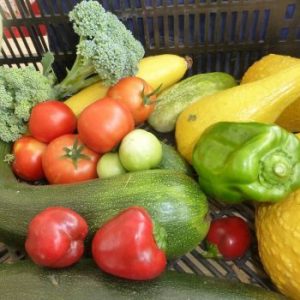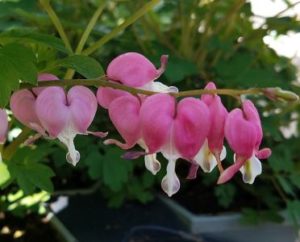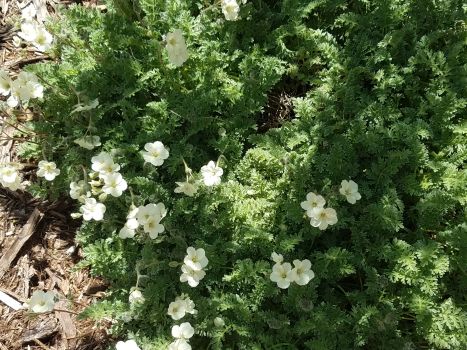Most herbs enjoy 6-8 hours of direct sun. Most, except lavender, are not used for their blooms so less direct sun may be acceptable in those cases. Herbs do best with well-drained garden or potting soil with organic matter and fertilizer. Plants should be allowed to dry slightly before watering thoroughly. The amount of water should be proportional to the plant size.
Fresh herbs can be harvested at anytime; use fresh, dried, or process for infusions/tinctures. Never remove more than 1/3 of the plant per week. Leaves can be cool or heat dried; keep them out of the sun or humidity during this process. Or… they can go straight to the freezer for storage.
Basil
Likes to have a pot by herself! (Diva) Or better yet, plant her in the ground but protect from wind. Basil prefers warm temperatures, but not too hot. It prefers adequate moisture, not too wet, not too dry! Keep pot size proportional to plant size!
Bay
Excellent addition to any stew pot, soup, or sauce. Likes well drained soil, usually in a container since it won’t winter over. Likes cooler weather, eastern sun.
Catnip
Easy to grow in poor soil with moderate water, grows 1-2′ tall. Reseeds itself freely!
Cilantro/Coriander
Likes a well-drained soil, moderate moisture. Full to part sun. May re-seed itself. The seeds are used as coriander.
Chives
Easy to grow perennial herb in full or partial sun. Grows in poor soil. Leave and blooms can be used. Reseeds itself freely!
Comfrey
Perennial herb used for medicinal purposes and for expediting compost piles. Best grown in the ground.
Dill
Great herb to be used in salads, sauces or on meat. The bloom attracts beneficial insects and pollinators. May reseed itself. 1-2′ tall
Eucalyptus
Used primarily for its essential oils and decorative foliage. Prefers moderate moisture. Best in a container if you want to overwinter. Otherwise plant in ground to cut and harvest before frost.
Fennel
Has a black licorice flavor. A large perennial herb. Loved by Black Swallowtail butterfly larva as a food source. Blooms attract all kinds of pollinators and beneficial insects. Up to 3′-5’H x 5′-7′ spread at maturity. Reseeds itself.
French Tarragon
Large perennial needs room! Perfect for vinegar, herbed butters and Bearnaise sauce.
Lavender
Attractive gray-green foliage, with dainty blue/purple flowers. Aromatic! Used for potpourri or dried flowers. Deters moths. Old English variety ‘Munstead’ strain is hardy in this climate. Blooms best in full sun. Requires well-drained soil!!! Prefers moderate to dry moisture.
Lemon Balm
Strong citrus flavor is used in teas and other drinks or wherever a lemon taste is desired
Mint
Used as a flavoring, medicinally and as a companion plant in the garden. Growth habit is aggressive so plant in a container and then plant container in ground to help conrol roots. Runners will root and spread so trim as necessary.
Oregano
Well behaved perennial herb. Keeps low to the gound 6″-12″. Used in Italian recipes. Can grow in part shade. Prefers well-drained soil.
Parsley
Leaves are used as a garnish or in salads. Also used by butterflies to lay its eggs and as food for its larva. Parsley grows easily in a pot or in the ground. Biennial herb – lasts 2 years.
Rosemary
Used in a variety of ways for cooking. It’s considered a shrub in warmer climates but will not winter over in Colorado. Best grown in a container, with fertilizer and a well-drained soil. Prefers full sun and will not tolerate freezing temperatures.
Sage/Salvia
Culinary and medicinal uses; hardy perennial with blue spike flowers midsummer. Develops a woody stem and is considered a low shrub. Survives best in the ground. Yellow sage is more tender and has a difference smell/flavor.
Savory
Annual herb does well in cooler temperatures. Prefers well-drained soil and full sun. Wonderful seasoning for salads and meat recipes.
Stinging Nettle
VERY beneficial medicinal herb for health and healing. Should be cooked before using — see name!
Thyme
Tender perennial with dainty foliage. Prefers well-drained soil and either part to full sun. Most commonly used in meat recipes. Lemon thyme gives a citrus flavor to salads or chicken. Also used decoratively in containers.

